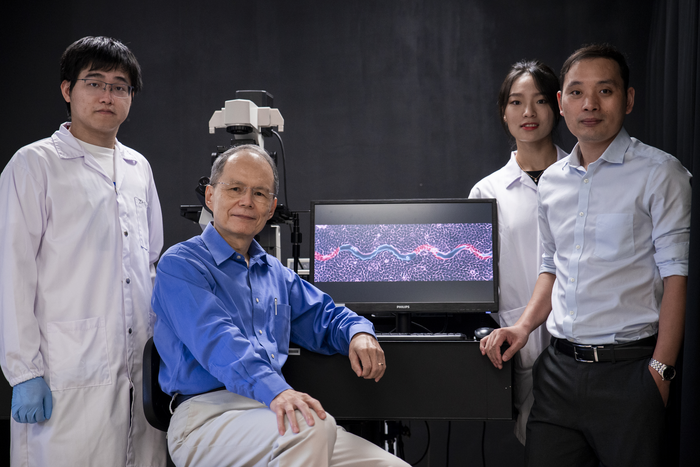Wavy wounds heal faster than straight wounds because shapes influence cell movements, a team of researchers at Nanyang Technological University, Singapore (NTU Singapore) study has found.

Credit: NTU Singapore
Wavy wounds heal faster than straight wounds because shapes influence cell movements, a team of researchers at Nanyang Technological University, Singapore (NTU Singapore) study has found.
Using advanced imaging equipment on synthetic wounds that mimic the human skin, the NTU Singapore scientists observed the motion of cells and found that those near wavy shaped wounds moved in a swirling manner while cells near straight wounds moved in straight lines, travelling parallel to the edges.
The NTU team concluded that the swirling or vortex-like movement is crucial to gap-bridging, in which cells build bridges to heal damaged tissues, and which accelerates the wound healing process in wavy wounds.
This is the first time that the relationship between gap bridging, and the speed of wound healing has been determined, said the NTU team of their findings published on 25 April in the Proceedings of the National Academy of Sciences (PNAS).
The scientists said their findings open the door to the development of more effective strategies to speed up wound healing, for better wound management, tissue repair, and plastic surgery.
Professor K Jimmy Hsia, lead investigator and President’s Chair in Mechanical Engineering, NTU School of Mechanical & Aerospace Engineering (MAE) and School of Chemistry, Chemical Engineering and Biotechnology, said, “Scientists have long known that the way you cut your skin affects how fast it heals. However, not much is known about why this happens, and the factors that could affect the healing speed. Our study contributes new knowledge to the promising field of mechanobiology, which could help surgeons develop better strategies for patients’ wound care.”
Commenting as an independent expert, Lim Chwee Teck, National University of Singapore Society Chair Professor, Department of Biomedical Engineering, and Principal Investigator, Mechanobiology Institute, said, “Wound healing is a crucial but less understood process of patient recovery. This interesting study sheds light on wound healing under complex geometries, providing crucial information that can contribute towards faster wound healing with less scarring.”
This study is aligned with the research pillar of the University’s NTU2025 five-year strategic plan, which focuses on health and society as one area with potential for significant intellectual and societal impact.
Different wound shapes induce different cell movements
An essential component of wound healing is re-epithelialisation, a process in which the epithelial cell – a type of cell found on the skin – moves to form a bridge between the wound and the skin, closing its gap.
While previous studies have found that zig zag wounds healed faster than straight wounds, little is known about how different wound curvatures (shape) and wound sizes influence healing efficiency, nor about the mechanism of re-epithelialisation.
To investigate, the NTU scientists prepared synthetic wounds with a range of widths (30 micrometres to 100 micrometres) and curvatures (radius of curvature: 30 micrometre, 75 micrometre,150 micrometre and straight line) to learn how cells moved to close wound gaps in different circumstances.
Using particle image velocimetry – an optical measurement technique for fluid flow – researchers found that wavy wounds induced more complex collective cell movements, such as a swirly, vortex-like motion. By contrast in a straight wound, cells moved parallel to the wound front, moving in straight lines like a marching band.
Wavy wounds heal nearly five times faster
The NTU team also observed the healing progress of the synthetic wounds over a period of 64 hours and found that the healing efficiency of wavy gaps – measured by the percentage area covered by the cells over time – is nearly five times faster than straight gaps.
First author of the study Xu Hongmei, a doctoral student at NTU School of MAE, said, “The highly nonuniform and rotational motion induced by wavy wounds allowed more opportunities for cells to move around, compared to straight wounds. This enabled cells to quickly connect with similar cells on the opposite site of the wound edge, forming a bridge and closing the wavy wound gaps faster than straight gaps.”
Co-lead investigator, Assistant Professor Huang Changjin at NTU School of MAE, said, “This study has revealed the cellular and molecular mechanisms of gap closure, contributing to the scientific understanding of the underlying principles of the wound-healing process. Clinicians and surgeons can use this knowledge to develop better strategies, such as incision methods, for patients’ wound management care in future.”
Other authors of the study include NTU PhD students Huo Yucheng and Zhou Quan, NTU undergraduate Abraham Wang, former NTU postdoctoral fellows Dr Bryant Doss and Dr Cai Pingqiang.
***END***
Journal
Proceedings of the National Academy of Sciences
DOI
10.1073/pnas.2221040120
Method of Research
Experimental study
Subject of Research
Cells
Article Title
Geometry-mediated bridging drives nonadhesive stripe wound healing
Article Publication Date
25-Apr-2023




